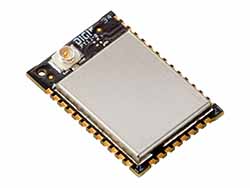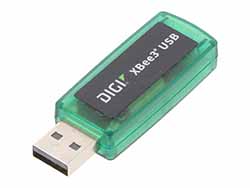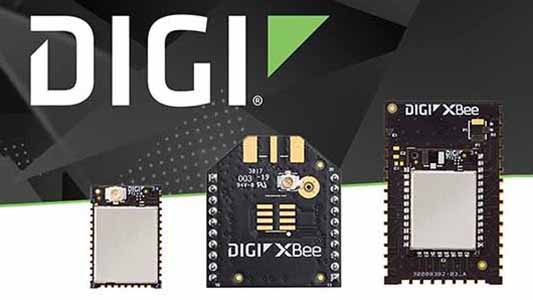“Internet of Things” () is an extremely popular phrase these days, although it’s wrongly associated primarily with devices such as and technologies such as or Wi-Fi. Meanwhile, the brand launched energy-efficient RF modules for wireless communication already 20 years ago. They operate in the 2.4 GHz band, transmit data through mesh networks, and can control a variety of receivers. This standard is called and offers some truly advanced possibilities.
Supplied by Digi, the XBee 3 products are a ready-made base for constructing complex IoT systems. The modules in this series:
- consume modest amounts of energy,
- can be configurated within just a few minutes,
- do not require an external microcontroller.
Below, we present some basic information regarding these products, and their example applications in complex and continuously operating systems. At the same time, please remember that this article describes only a part of the range of products offered by Digi, which also includes RF modules operating in lower ISM bands ().
In this text, we will describe such matters as:
- Differences between ZigBee and DigiMesh networks
- Distinguishing features of XBee modules by Digi
- Application of mesh network in urban infrastructure
- Commercial, scalable systems based on IoT technologies
XBee 3 modules
The Digi XBee platform is a complete, scalable system. It comprises both hardware solutions and software tools.
The fundamental advantage of the XBee3 environment is the easy configuration of network parameters. To program a module, you need to use XCTU® – the proprietary, freeware app developed by Digi. Thanks to its graphic interface, the module firmware can be updated and pre-set effortlessly.
During the first level of configuration, you select the module operation protocol (e.g.ZigBee, 802.15.4, DigiMesh). If you decide to use the classic ZigBee network, the next step will be to select which function is to be served by the given unit: the coordinator, the router or the end device.
- The coordinator is a unit that is used to create and manage the network. Only one device in the infrastructure can serve this function.
- The end devices are the executive components (sensors, controllers, etc.) for sending and receiving data, which require a router to connect to the network. These modules generally operate in the low power consumption mode and are periodically brought out of this mode for data transmission.
- Routers can operate in the same way as any end device, but at the same time take part in network propagation (extending its reach) as well as buffering and routing data from other modules. Unfortunately, they must therefore be constantly active and cannot enter a lowered energy consumption mode ().
Note! This division and such limitations do not apply to the DigiMesh network! There, each device operates separately, and it can receive/transmit data to and from other modules and also save energy.
Further configuration of the device is also done with the use of XCTU®, although it’s not the only option. The module can be programmed with AT commands, MicroPython or remote API (in selected cases also with Bluetooth and a special app for a smartphone or a tablet). As the devices are equipped with GPIO pins, UART, I2C and SPI interfaces the need to use additional microcontrollers is essentially eliminated – in such a case, the XBee board will directly control components.

XBRR-24Z8UM-J
A micro XBee 3 module (13×19 mm).
In other words: each Digi module is a ready-made platform on which you can base your IoT project. For buyers implementing the XBee 3 solutions, this means far-reaching savings and accelerated development and prototyping of new products. Moreover, the clients can rest assured that the communication between the devices complies with the applicable laws and that their product won’t cause any interference in the radio band.
Operational specifications and parameters
The XBee 3 modules available from the TME catalogue offer 8 dBm (XBee 3 series) and 19 dBm (XBee 3 PRO series) transmission. They are available in several sizes, including a new “micro” format (13×19 mm), which is shown in the video below. Our offer includes components for surface mounting (SMD), or fitted with pin strip headers for soldering (THT) and also socket mount versions. All these products can operate in temperatures ranging from -40°C to 85°C.
Depending on the model, the products are supplied with a voltage range of 1.71…3.8 V or 2.1…3.6 V. When selecting a module for your project, it is worth paying attention to the method of connecting the antenna. Some modules are fitted with SMA or u.FL connectors, other ones use a built-in antenna in the form of a PCB trace. There’s also a fourth option, i.e. a radio signal broadcasting to the “RF PAD” field. For optimal operation (receiver sensitivity of -103 dBm), the modules require connection of an antenna designed for operation in the 2.4 GHz band.
The XBee 3 products offer native support for AES128 and AES256 data encryption to ensure a high level of security for the transmitted data and information and protect the devices against unauthorised access.
Case studies, i.e. examples of applications
The Digi brand has been on the market long enough to boast numerous successes achieved by its clients with the use of the XBee technology. Let’s have a look at two cases of large-scale projects carried out with the use of Digi technologies.
Streetlighting and Owlet Nightshift
The first example is the Owlet Nightshift system developed by German company Schréder from Mainz. It responded to the need for cost saving, when the project designers found the statistics suggesting that street lighting devours even up to 40% of the city’s energy costs. Those figures resulted from non-economical and outdated methods of illumination control. The overly simplified control also meant that faulty street lampposts were serviced mainly when citizens reported malfunctions to the city authorities.
XB3-24DMST-J documentation screen
An example of connecting the DigiMesh network to a control panel using a gateway.
The Owlet Nightshift system was developed to enable remote controlling and monitoring lamppost operation with the use of the already existing infrastructure. LED panels are installed in the existing lampshades, powered with the same lines that were used to supply energy to classic light bulbs. Each panel (and thus each lamppost) has its own XBee communication module and a controllable power supply. Lampposts are grouped into segments and connected wirelessly to the controller developed by Schréder (Owlet Segment Controller). The OSC is fitted with a 2G/3G, modem, and using the GSM network, network fragments are centralised in such a way that the software of each lamppost can be updated remotely. This eliminates the need to directly control individual lampposts and at the same time allows to keep full control of their operation.

A network constructed in this way is cheap to implement. Moreover, it enables fine regulation of lighting to obtain optimal parameters for its operation. This translates into major savings (Schréder estimates they can reach even up to 90%). Primarily, the lighting intensity can be adjusted depending on the needs: not only the time of day and year but also weather conditions. The lampposts are turned on, in addition to the standard schedule, during stormy days and when it’s heavily clouded. Moreover, the scope of illumination is limited during bright nights caused by the albedo effect (when it’s snowing). The control panel receives an immediate signal if a lamppost malfunction occurs (XBee modules report abnormal operation parameters or fail to report due to the lack of power) – and when one lamppost is not working, others can temporarily increase the intensity of emitted light to compensate for it and maintain safe road conditions.
XU3-A11
USB adapters allow to connect a laptop directly to the XBee network.
Monitoring food storage and transport conditions

Another example of the wide possibilities for the implementation of the XBee modules is the system used by Belgian company RMONI. Its purpose is to register/monitor control parameters during food (and pharmaceuticals) storage and transport. In this field, the information on conditions in which the goods were at every stage of distribution is legally required. This applies mostly to medicines, fresh fruit, vegetables, dairy, meat and fish. The temperature and humidity of the air directly influence their fitness for consumption/use. If the control process is not automated, the manufacturers, distributors and retailers are forced to devote their employees’ time to periodically register data from thermometers and hygrometers. That’s where the RMONI brand system comes in handy.
XB3-24Z8PS-J
Selected XBee 3 modules require the transmission of current not exceeding 40 mA.
The solution developed by the Belgian manufacturer combines three components: sensors connected to wireless communication modules, transmission gateways and software for registering data in the cloud. The sensors are placed at every point requiring the control of environmental conditions. As XBee modules are energy-efficient, such recorders can be installed in containers, trucks and other places with no permanent access to a power grid. Distribution units (including warehouses) are equipped with wireless network gateways with which each sensor transmits collected information to a central database. Of course, this process can take place in real time, e.g. in a hospital, where literally hundreds of points in which medicines, blood and goods are stored are monitored. In the case of multi-store chains, monitoring the time and conditions of food storage helps improve the management of the distribution and sales of goods. According to RMONI’s statistics (including the example of SPAR Lambrechts supermarkets), the implementation of this system has reduced waste due to food spoilage by 10%.












